





Few plants say the tropics more effectively than do tree ferns, yet thankfully many species of tree ferns are fairly cold hardy, enabling gardeners throughout the world to use these for decoration and landscaping in climates much less tropical than from where they originate. The tree fern is a commonly used plant in landscaping designs from Britain, the Pacific Northwest, the Mediterranean, Southern California, the Southeast US and in tropical climates all over the world. They are basically living works of art, as well as useful shade for smaller, understory, more tender tropical and subtropical plants in marginal climates. The following is a brief overview of some of the more commonly grown cold hardy tree ferns in cultivation.
Tree ferns are not really true trees, at least in terms of having a true trunk and branches. Ferns develop fronds and these fronds are not really branches, but extensions of the growing center or meristem that radiate 360 degrees, not unlike with palms, cycads and many other tropical plants.The fronds all start from curled up structures at the top of the fern call croziers. And a crozier, or fiddlehead, is really the very tip of a specialized root, called a rhizome, that has grown up all the way from the ground within the trunk itself. The trunk is really a solid, upright accumulation of above-ground rhizomes that support the fronds. Cutting through a fern trunk will reveal that it is made of these roots all tightly packed together in this rigid supporting structure. Like trunks in other plants, these rhizomes not only support the crown, but they also transport water and nutrients back and forth from/to soil and leaves.
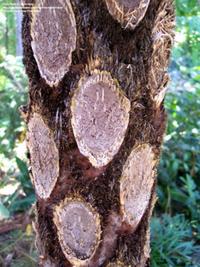
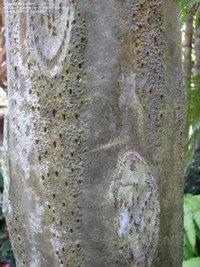
Tree fern trunk showing leaf scars, and old hardened trunk that is more like concrete in texture
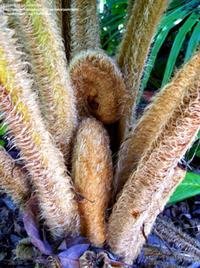
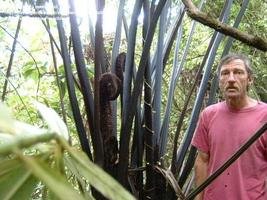
leaf bases of Cyathea princeps, and Cyathea medularis- note the scales on the croziers (like thick, stiff hairs)
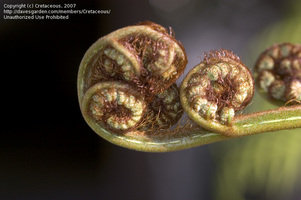
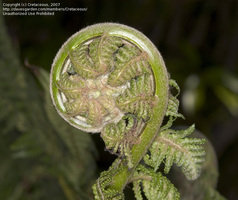
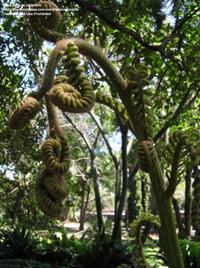
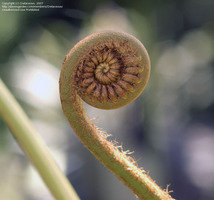
Croziers of several different tree ferns (from left to right and top to bottom): Cyathea cooperi (photo by Cretaceous), Dicksonia antarctica (photo by Cretaceous), Angiopteris and Sadleria (photo by Cretaceous)
The leaves, or fronds, are further divided up into leaflets, which arise in a very symmetrical pattern from the rachis or central leaf structure. This symmetry is one of the characteristics that make ferns such wonderful and ornamental garden/potted plants. The leaflets are usually deeply divided creating a very even, symmetrical and intricate lacy pattern that is like living art.
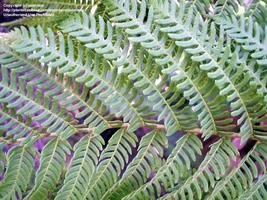
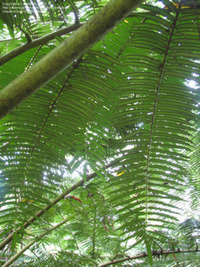
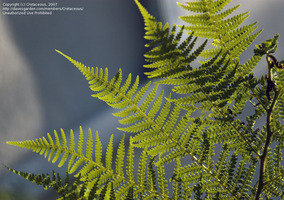
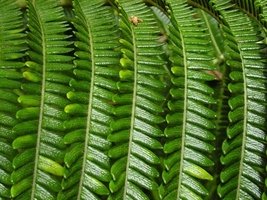
close up of several tree fern leaves (from left to right and top to bottom): Cyathea, Antiopteris, Dicksonia (photo by Cretaceous) and Sadleria (photo by htop)
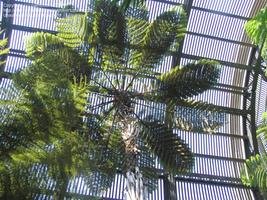 tall Cyathea from below showing radial symmetry
tall Cyathea from below showing radial symmetry
Ferns reproduce via spore formation. Spores are the nearly microscopic structures that form within darkened structures (sori or sporangia) on the undersides of mature fronds. If the plant is being grown in ideal conditions (for example, similar to its environment of origin) the spores may germinate in the surrounding soil and form new microscopic tree ferns. However, in most environments unlike those the plants came from, this is very unlikely to happen, and special steps need be taken if one wants to grow ferns from spore. But that is a discussion for another article. For more information on taking care of ferns and talking to those that grow a lot of ferns, visit the American Fern Society webpage.
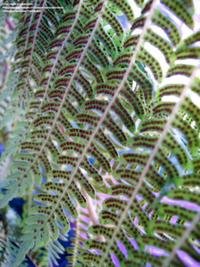 Sori (sporangia) on the undersurface of a Cyathea cooperi
Sori (sporangia) on the undersurface of a Cyathea cooperi
Tree fern petioles and rhizomes are often covered with either scales or hairs. Though these ferns may LOOK soft and luxuriant, most tree ferns have fairly rough fronds and these hairs/scales are not only NOT soft, they are also potent irritants. Getting these hairs or scales on one’s skin or in one’s eyes can be a very unpleasant experience. One of the names for Dicksonia antarctica is the Soft Fern, which is truly a misnomer, as it is a very rough, scaly, and bristly-haired plant that is not a comfort to rub up against.
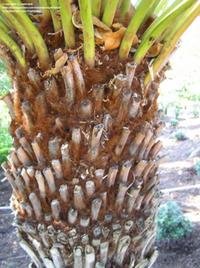
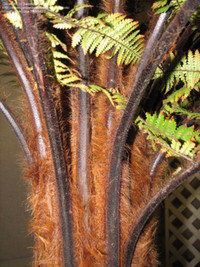
Dicksonia antarctica or Dicksonia squarrosa may look soft and cuddly from a distance, but these hair fibers are rough and extremely irritating if they get in eyes, under one's clothes or into one's lungs (usually happens during pruning)
A few species of tree ferns can also be grown from cuttings, something which I personally have not had much luck with. Dicksonia antartica is one fern often propagated in this fashion, with the trunks being sawed off and rerooted, while the original tree grows another head. These beheaded trunks, sans fronds, can be found at nurseries sometimes. Cibotium glauca, a Hawaiian tree fern, is often grown from a cutting made off one of its suckers, but these are the ones I have never been able to root. Cyathea species and most other genera will not grow from trunk cuttings!
The term cold hardy is a relative term of course. No one in USDA zones 1-5 will have much luck growing these outdoors, even with substantial winter protection, though some manage somehow. But in the warmer zones, there are several species that perform pretty well, and the warmer and wetter it gets, the more options open to the would-be gardener/landscaper.
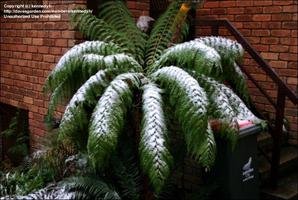
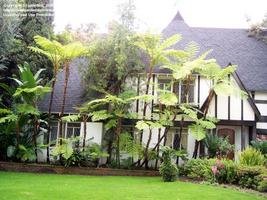
Dicksonia antarctica under snow (photo by kennedyh) and Blechnum gibbum fried by a cold snap of only 27F
But cold is not the only limitation of tree ferns, as it is not with most ferns. Heat, particularly dry heat, is very hard on most ferns, and dry, desert-like climates pose huge barriers to growing many ferns species, at least without some microclimate protection or outside a temperature/humidity-regulated greenhouse. I personally struggle much more with the few tree ferns I have in the summer than I do in the winters here in Southern California.
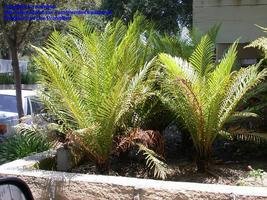 My Cyathea cooperi after heat wave
My Cyathea cooperi after heat wave
There are numerous techniques used for protecting ferns during periods of cold and heat. Basically, for heat, the main thing that needs to be done is keep these plants moist. The ‘business’ parts of the tree fern that need to be keep moist are the rhizomes (trunk) and crown. It helps to keep the leaves wet, but unfortunately they do not stay wet very long unless ones keeps them constantly misted. The true roots below the soil surface do not need to be kept constantly wet as they are protected somewhat by the soil. Roots kept wet all the time, particularly in poorly draining soils, will rot easily and then the whole tree will be lost. But keeping the trunk and crown moist during periods of excessive heat can mean the difference between a horrific, dead-looking stump and a luxurious set of fronds atop a healthy trunk. Most experienced tree fern growers in warm, dry climates either plant their trees in shaded, protected moist microclimates, perhaps near a pond or fountain. And most serious growers have drip systems set up at the tops of the trees keeping the trunks and crown wet most of the time. Still, periods of heat beyond the tolerable will damage the fronds and cause them to shrivel up and look unsightly.
Cold protection ranges from planting trees against buildings, under other trees or in other protected microclimates, to keeping them in pots and moving them indoors. Some will dig up their plants each fall and overwinter them in burlap. Still others wrap in various protective materials like bubble wrap, heavy blankets etc. For more on cold protections techniques, visit the Cold Hardy Tree fern page: http://www.angelfire.com/bc/eucalyptus/treeferns/tfprotection.html . This is an excellent web site for all sorts of information on tree fern cultivation, by the way.

though rarely threatened by cold, these Cyathea cooperis in Los Angeles are grown next to buildings, usually on the east side so they get mostly morning sun
Tree ferns all have very high light requirements. However some still manage to perform well as house plants, as long as one can keep them sufficiently moistened (lack of humidity is the second biggest problem when growing tree ferns indoors behind sufficient lighting). Few tree ferns can tolerate full sun in hot, arid climates, but in humid or cooler climates, many prefer full sun locations and stay much healthier with a lot of direct sunlight.

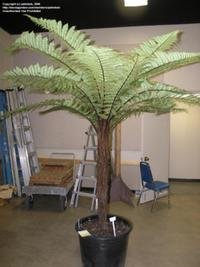
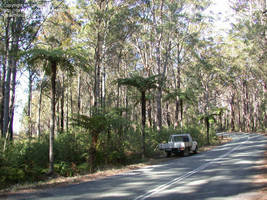
Blechnum gibbums in Los Angeles in nearly full sun on right. Dickosonia squarrosa grown in a pot and indoors here, but outdoors in shade most of the time (middle photo) and Cyathea cooperis along the road side in Australia (last photo by ginger 749)
Soils should be acid and well draining, though I have learned most common species seem to grow well in most soils as long as they are mulched well and not very basic (a rare condition in southern California). Though tree ferns will rot in poorly draining soils if kept excessively wet, they also suffer if soils dry out too much. This is why mulching soil is so important when growing these in the landscaping. Planting a lot of low-growing shrubs around their bases will also work well to protect the sensitive roots below from drying out too much.
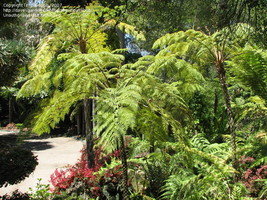
These Cyathea cooperis live in a fern grove, which keeps the soil constantly moist
Fertilizers heavy on the nitrogen portion are recommended for tree ferns, but one should be careful not to over-fertilize them. It is much easier to give too much fertilizer than provide too little. In Southern California, most tree ferns need very little fertilizer other than mulch or compost as the soils tend to be pretty rich here.
Cibotium- these are Pacific Island or Central and South American trees and shrubs though only a few are common in cultivation. Cibotium glaucum, one the Hawaiian tree ferns, is probably the best known of this group and it is a wonderful tree fern that actually does have soft hairs (leaves still somewhat scaly and rough to the touch). One can see these all over the place as landscape plants if visiting Hawaii. But they are also commonly grown in more marginal climates like Southern California and similar Mediterranean climates. This tree grows slowly to up over 10 feet tall (VERY slowly in southern California). It is not one of the more hardy tree ferns tolerating temps down to about 28F before they suffer significant leaf damage. They also very much resent dry heat and winds, so best grown along the coast in protected courtyards in the marginal climates. These prefer minimal direct sunlight in marginal climates, but still need a lot of light and do not do very well as indoor ferns.
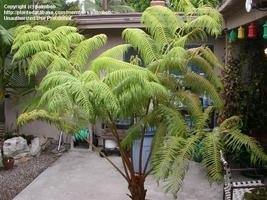
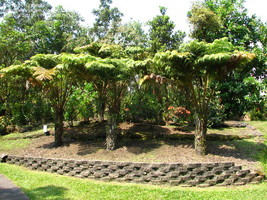
Cibotium glaucum in California and in Hawaii
Cibotium shiedei, or the Mexican tree Fern, is really more of a shrubby plant rather than a true tree fern, suckering and spreading in nature. But it is a very soft and user-friendly plant that tolerates even inland climates in protected gardens in southern California, as long as kept somewhat moist in hot summers.
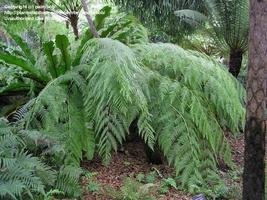
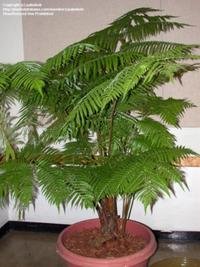
Cibotium schiedei outdoors in California, and Cibotium chamissoi, another relatively commonly grown Hawaiian tree fern with slightly less droopy leaves
Cyathea- This is the largest family of tree ferns and there far too many species to touch upon here. Only 7 to 10 are ‘common’ in cultivation and considered cold hardy, while the rest are far too tropical in their requirements to be grown anywhere but in the tropics. Only 3 or 4 of the hardy species are likely to be encountered by most casual tropical plant collectors.
Cyathea cooperi is by far the most commonly grown species throughout the world- this is an Australian species that is fairly fast growing and can get up to nearly 30 feet tall. Though very common it is not one of the more hardy Cyathea species and can show signs of damage at or above 27F. Last year mine defoliated twice- once in the heat of summer (120F) and once in the winter (25F)… yet still it keeps on growing. There are several cultivars of this plant, the most familiar being ‘Brentwood’. Most Cyathea cooperi encountered in Australia are actually this form and it is a much more robust form that the more commonly grown, scrawny, sluggish ‘type’ form encountered in most landscapes in southern California. This is a tree that does best if grown in a location where it gets at least partial day sun, but not hot, afternoon sun if grown inland. One can see many of these grown about southern California that are very poorly grown primarily due to lack of afternoon sun protection and/or lack of keeping the crown and trunk wet in warm weather.
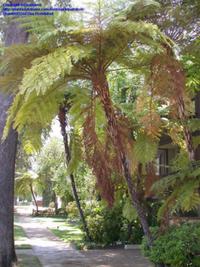
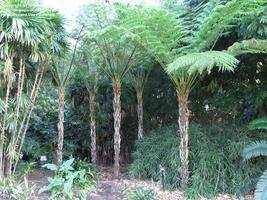
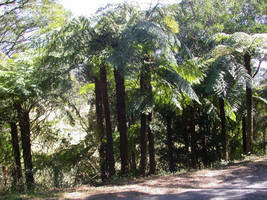
Cyathea cooperis in California- a very common landscaping plant. The second two photos are of the Brentwood form- middle photo in California, and the photo on the right shows these ferns lining a road in Australia (photo by ginger749)
Though much less common, Cyathea medularis is very tall and excellent landscape fern for marginal climates and seems to have a bit more cold tolerance than Cyathea cooperi. This is a fern native to New Zealand and some Polynesian islands and is one of the largest of the cold hardy tree ferns growing up to over 50’ tall. It has ornamental black leaf bases and horizontally oriented leaves. Though a slow grower, it picks up a speed a bit once it gets some size and can be an excellent landscape tree to plant other sensitive plants under.
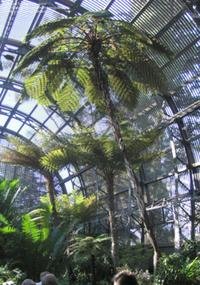
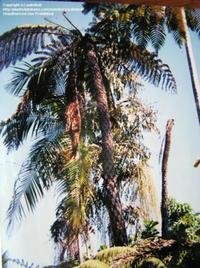
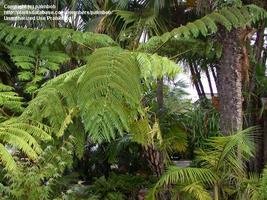
Cyathea medularis in large shade structure, out in the open and under a palm canopy, all southern California
Less commonly encountered but successfully grown Cyatheas in southern California include Cyathea brownii (a huge species that can grow up to 100’ in its native Australia), Cyathea dregei (probably the most cold hardy of the tree ferns), Cyathea dealbata, Cyathea tomentosissima, Cyathea australis (C. cooperis are commonly misidentified as this), Cyathea princeps (one of the most beautiful but finicky species), Cyathea amaragarensis and Cyathea spinulosa.
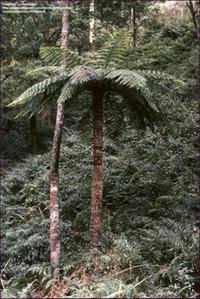
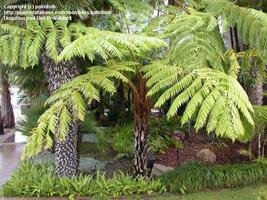
Cyathea amaragarensis in California, Cyathea australis (in Australia- photo by kennedyh) and a young Cyathea brownii in California
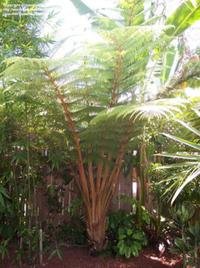
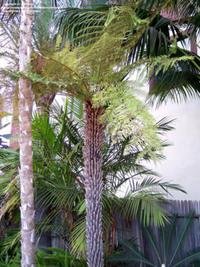
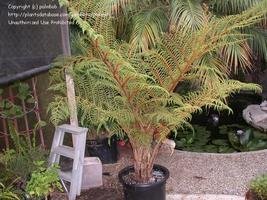
Cyathea princeps, Cyathea spinulosa, and Cyathea tomentosissima, all in California
Dicksonia- this genus includes the most commonly grown tree fern in cultivation- the Male fern or Soft Fern, Dicksonia antarctica. It is a very common species seen frequently in landscapes from Britain, to the entire west coast of the US and, of course, Australia and Tasmania, its native lands. This is a long-lived, slow-growing species (lives hundreds of years and can grow up to 50 feet eventually, though usually not in cultivation, at least not in the more marginal climates). One can see these trees all over southern California as a basic component of public landscaping both inland and along the coast. It is a very durable species handling cold down to the low 20s, and tolerating some direct sun inland. However, hot, sunny days in summer still thrash this species and make it look unsightly if the trunk, crown and leaves are not watered frequently that time of the year.
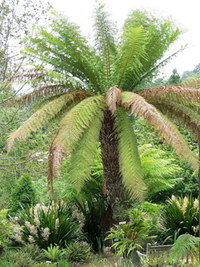
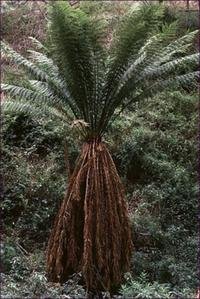
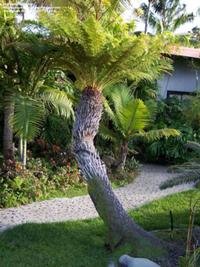
Dicksonia antarcticas in California (left and right) and in the wild in Australia (middle). photo on left by Calif_Sue, and middle photo by kennedyh
Another Dicksonia species encountered more and more frequently is Dicksonia squarrosa. However, it is still somewhat rare in cultivation and large, mature palms are rare outside of New Zealand. This tree has a markedly black trunk covered with golden hairs, and the undersides of the leaves are distinctly light color. It is a species that sometimes grows suckers right against the base. It is cold hardy down to about 25F. My 1’ tall seedling had no damage at 25F and it was fully exposed to the elements. However, it definitely resents the hot summers and has to be watered nearly daily during heat waves.
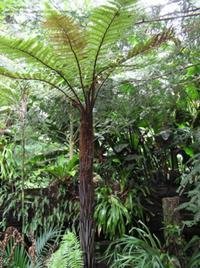
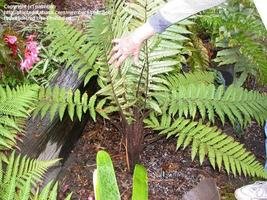
Dicksonia squarrosas in California. Photo on right shows the whitish undersides of the leaves, a distinctive characteristic
Several other species encountered in cultivation include Dicksonia fibrosa (also from New Zealand) and Dickosnia sellowiana (from Mexico and South America).
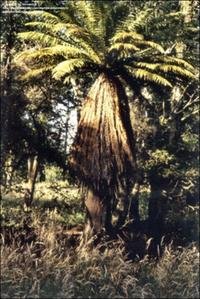
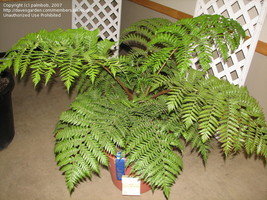
Dicksonia fibrosa in Australia (photo by kennedyh) and Dicksonia sellowiana
Sadleria- this genus has only one commonly grown species: Sadleria cyatheoides and it is another commonly encountered landscape fern in Hawaii. However, in the hotter/colder southwest coast of California this is a tough grow in all but the most ideal microclimates as has a pretty narrow range of temperatures in which it is happy. Still, many try to grow it because of its wonderfully ornamental leaves that are very tightly spaced and intricately symmetrical. It is a costly and sensitive species and sought after by many growers. In Hawaii it is often a epiphytic species growing in tree trunks, including those of other tree ferns.
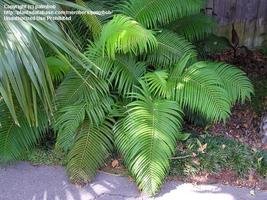
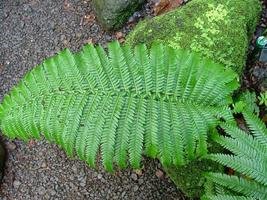
Sadleria cyathioides in California, and Hawaii on right (right photo by george4tax)
The ‘short’ tree ferns:
Blechnum is a genus of fern which has a few species that develop into small ‘trees’, or at least single-stem plants that looks like bonsai trees. The most commonly grown of these is Blechnum gibbum, the Silver Lady fern. It is a not a very cold hardy species, defoliating at or around 27F. But it does tolerate full sun fairly well in all but the hottest, driest inland climates, as long as it gets some regular watering. A similar looking species with slightly wider leaflets and new red leaves, Blechnum brasiliense, is similarly cold hardy, though less so to full sun, and an excellent, though somewhat finickier landscape plant for marginal warm climates.
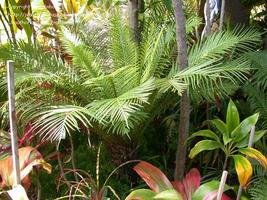
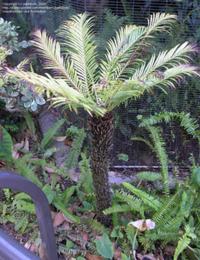 Blechnum gibbums in California
Blechnum gibbums in California
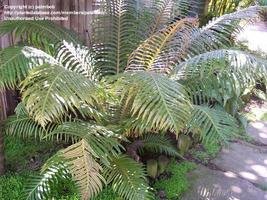
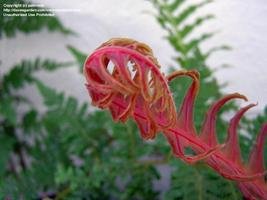 Blechnum brasiliense (new leaves are bright red)
Blechnum brasiliense (new leaves are bright red)
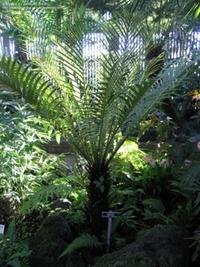
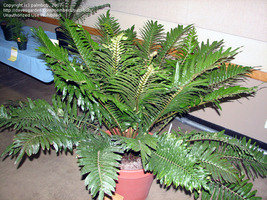 Blechnum moorei and Blechnum tabulare in California
Blechnum moorei and Blechnum tabulare in California
Angiopteris is a genus of tree ferns that really have only a short thick trunk. The most common species, Angiopteris evecta, or Mule’s foot fern, is a huge species with a spread of up to 20 feet or more. Though this plant is extremely marginal in dry climates like southern California, it has some cold hardiness in wetter climates like south central Florida where it is still exposed to periodic frosts and rare freezes. It is very needy of humidity.
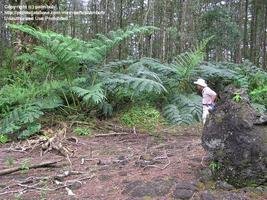
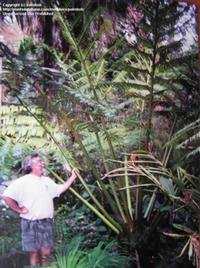
Angioptera evectas in Hawaii and in the southern half of Florida
For more on Cold Hardy Tree Ferns visit this website: http://www.angelfire.com/bc/eucalyptus/treeferns/#blechnum
(Editor's Note: This article was originally published on January 31, 2008. Your comments are welcome, but please be aware that authors of previously published articles may not be able to respond to your questions.)
Copyright © www.100flowers.win Botanic Garden All Rights Reserved